P.J.
0
Lord Hanuman’s Giant Footprints throughout Asia
Aug 13, 2015
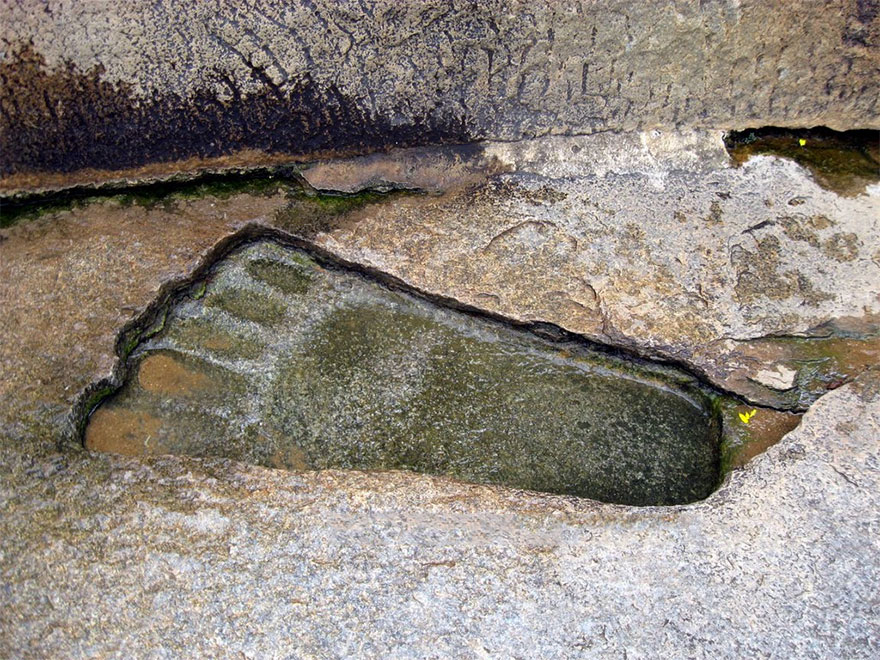
Giant Footprint at Lepakshi, Andhra Pradesh
Most people are familiar with Lord Hanuman, the great devotee of Lord Rama mentioned in the Ramayana, but not everyone is aware that there are still physical traces of his ancient presence on earth in the form of his giant footprints left impressed into the solid stone where he lept and landed in different countries. Below we will show you four such places where Lord Hanuman’s footprint can be seen, as well as some examples of other giant footprints throughout the world, some of which are hundreds of millions of years old.
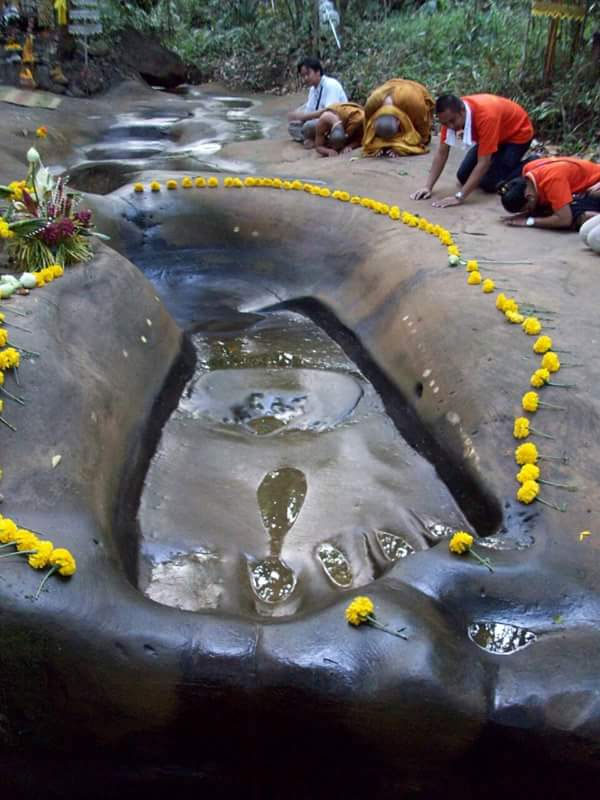
This above picture is of Lord Hanuman’s footprint in Thailand. In Thailand there is a book called “The Ramakien” which means “The Glory of Rama”. It is a Thai version of the ancient Sanskrit epic Ramayana. The ancient capital of Thailand used to be named “Ayutthaya”, which is named after Lord Ramachandra’s capital of Ayodhya in India. The present capital of Bangkok was originally a small trading post of Ayutthaya, located 40km away.
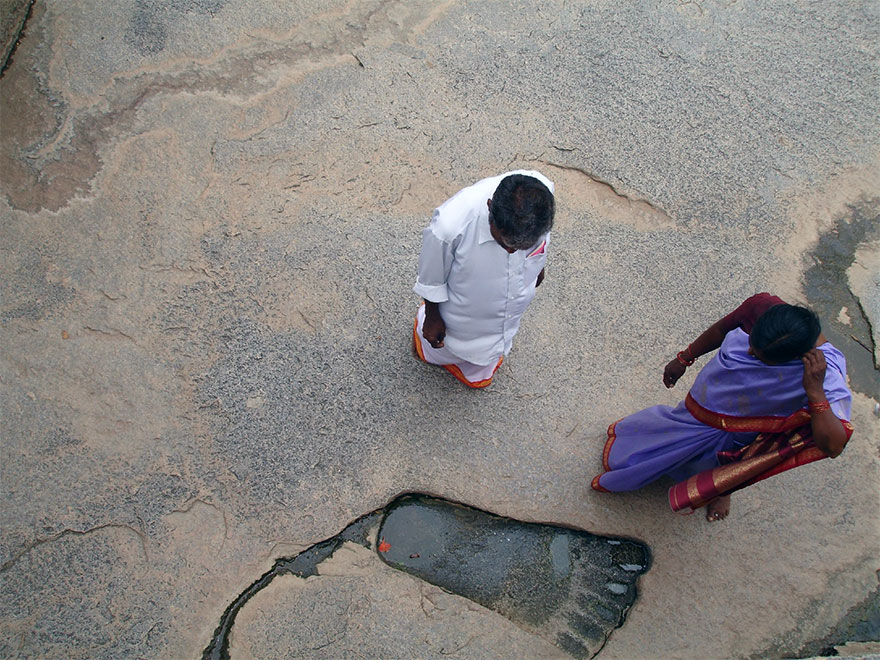
The next three pictures show the footprint at Lepakshi in Andhra Pradesh. Some legends say the footprint is of Lord Hanuman, and others say it is the footprint of mother Sita.
The historic town of Lepakshi has a connection with an occurrence in the Indian epic of Ramayana. While Ravana was kidnapping Sita Devi and heading towards Lanka a bird named Jatayu had battled with him. He could not fight for long and fell at this place. According to the Valmiki Ramayana, Lord Rama accompanied by Lakshmana met the dying bird Jatayu at this spot. They helped him attain moksha by uttering the words “Le Pakshi,” which is Telugu for “Rise, bird”. Hence the name of the place has become Lepakshi.

Giant Footprint at Lepakshi, Andhra Pradesh
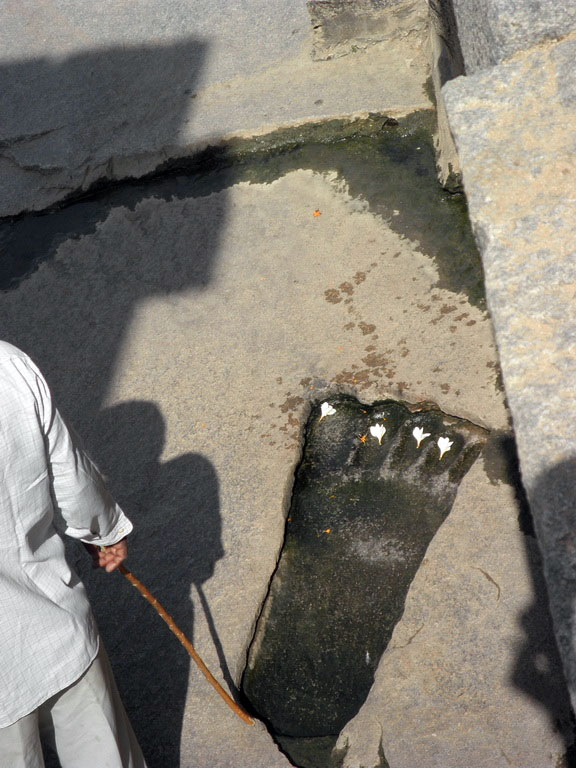
Giant Footprint at Lepakshi, Andhra Pradesh
The next picture is of Lord Hanuman’s footprint in Sri Lanka. It is believed that when Hanuman lept from India to Sri Lanka he landed at this spot and the force was so great that his footprint was left pressed into the solid stone.
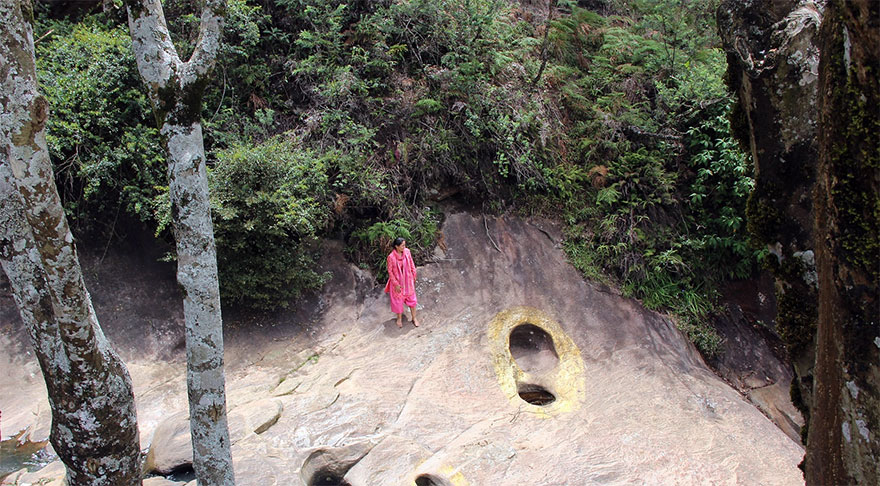
In Penang, Malaysia there is also a footprint of Lord Hanuman, which is kept within a small temple. In the next picture you can see the footprint. Visitors throw coins on the footprint for good luck.
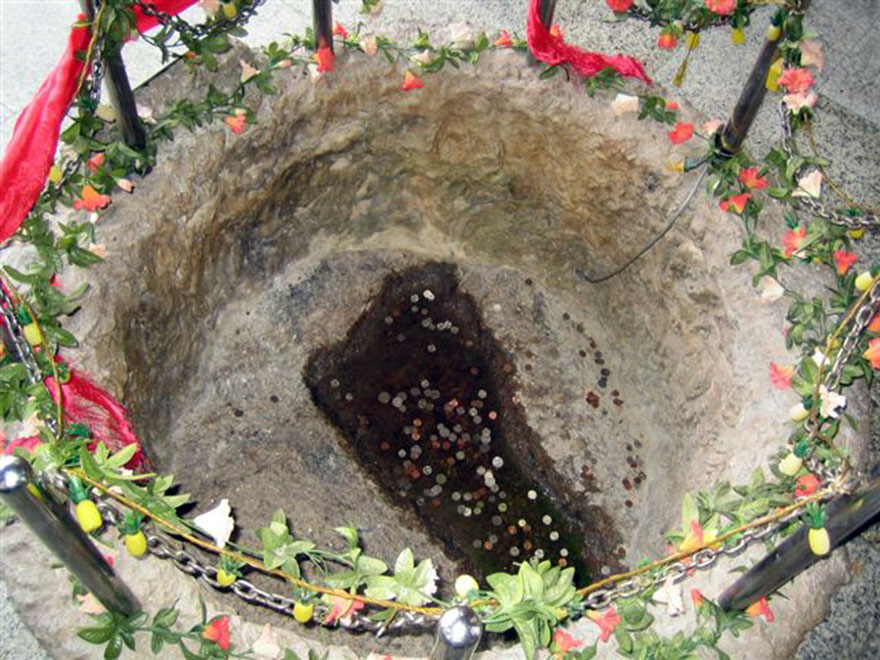
Besides these footprints of Lord Hanuman, there are many other giant footprints found throughout the world, which reveal the presence of super powerful beings on the earth in ancient times. In our Hindu scriptures we find countless references to powerful beings in the previous ages. Besides the presence of Devas (Demigods) visiting to the earth, there were many other higher species of humans such as the Yakshas, Rakshashas, Vanaras, and Gandharvas. Descriptions of these people found in the Puranas show they were often gigantic in size, flying in celestial airplanes that could travel from planet to planet, and wielding powerful weapons that were more effulgent than the sun.
In fact, J.R. Oppenheimer, the father of the atomic bomb, after the first successful test, quoted from the ancient Hindu scripture Bhagavad Gita to describe the weapon he had just invented. He also once hinted at the possibility of weapons on par with the nuclear ones he was working on having existed in previous eras, particularly those of the Ramayana and Mahabharata. Oppenheimer also claimed that, “access to the Vedas is the greatest privilege this century may claim over all previous centuries.” So while some people are quick to call our ancient scriptures as mythology, those who have scientifically studied the matter are more apt to consider them as actual ancient histories of the world.
The gigantic footprints found throughout the world fit in nicely with the descriptions found in the ancient Vedic scriptures. Even the Bible gives mention to the giants who walked the earth in ancient times:
“There were giants in the earth in those days; and also after that, when the sons of God came in unto the daughters of men, and they bare children to them, the same became the heroes and famous warriors of ancient times.” Genesis 6:4
Some of these footprints are hundreds of millions of years old, such as this next photo of a footprint that is over 200 million years old in South Africa. Of all the world scriptures, only the Vedas contain references to vast time spans, covering millions, billions and even trillions of years. Further, only the Vedic scriptures state that man has existed on this earth for hundreds of millions of years. The Vedic view is that there are many major and minor cycles of destruction (called pralayas) that occur over the life of the universe, which lasts trillions of years.
Just as there are seasons in the year, so there are also four cosmic seasons called as Yugas. The total time span of the four cosmic seasons is 4,320,000 years. Between each Yuga there is a partial dissolution in the world, where the world is destroyed through flood, fire and other natural disasters. The present age of Kali Yuga began 5,117 years ago, which also matches closely to both the Mayan calendar for the last destruction, and the Bible’s narration of the flood on the earth.
The Vedic scriptures describe that the present Kali Yuga is an age of evil, selfishness, destruction and all bad qualities. The word Kali means war in Sanskrit, so Kali Yuga means the age of war and destruction. The Vedas tell us that in this age the celestial beings who used to visit the earth avoid the earth due to the darkness of the age of Kali. That is one reason why today all we find are remnants of their presence in the form of their ancient footprints in stone.
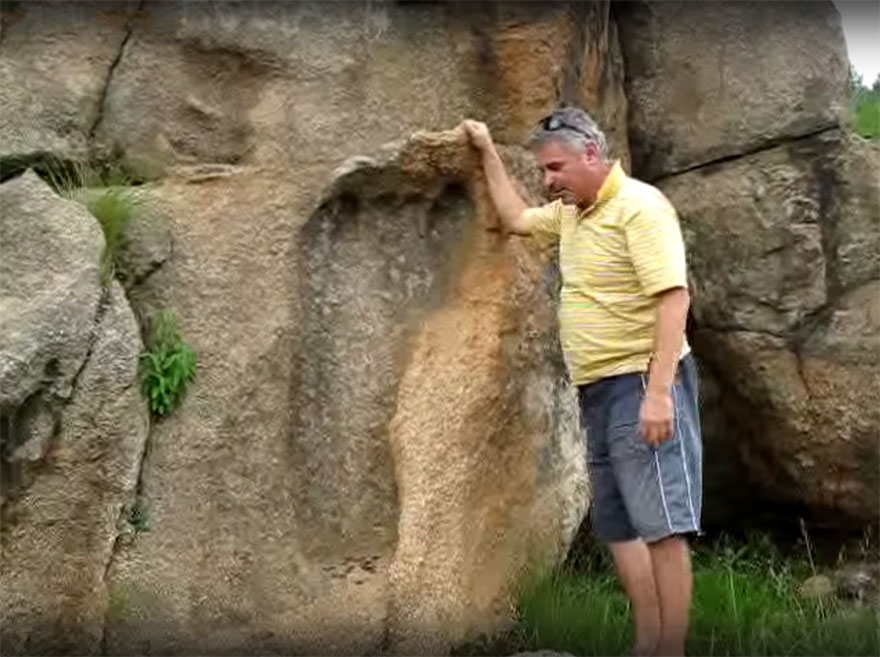
Giant Footprint in South Africa
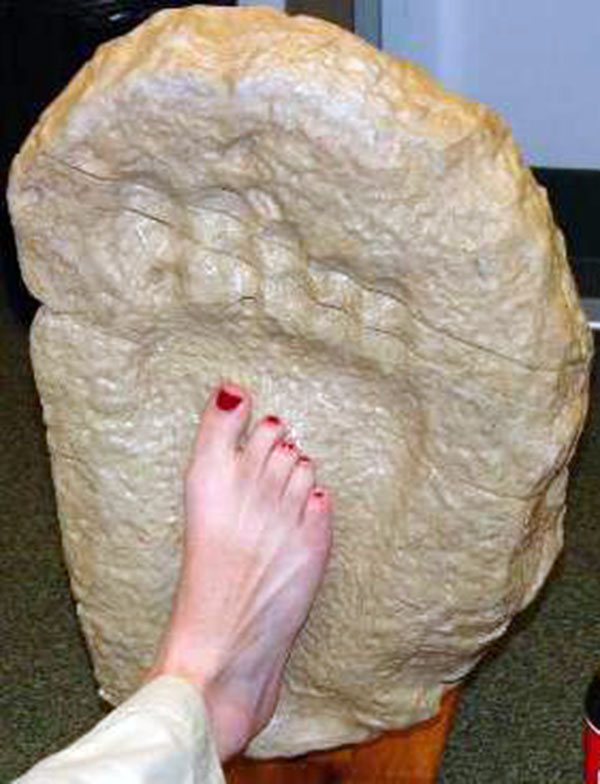
Giant Footprint Found in Texas, USA
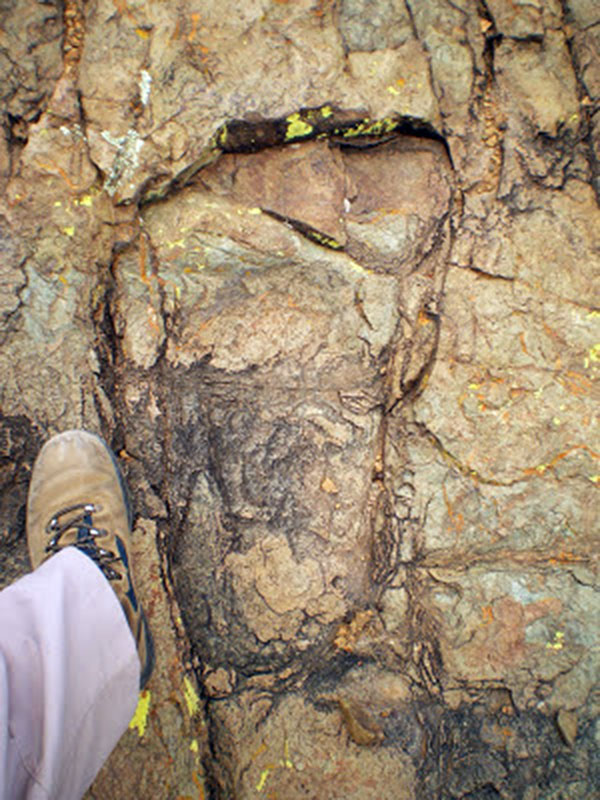
100 Million Year Old Giant Footprint in Canada
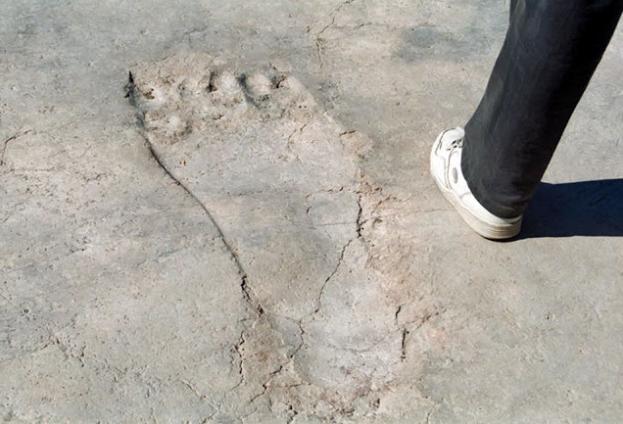
Footprints at Ain Dara Temple, Syria
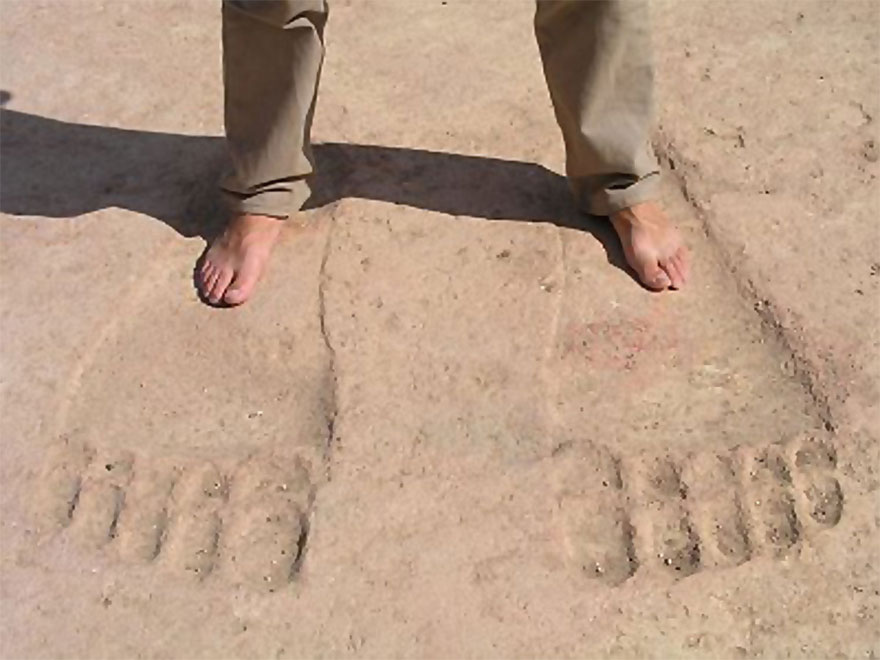
Footprints at Ain Dara Temple, Syria
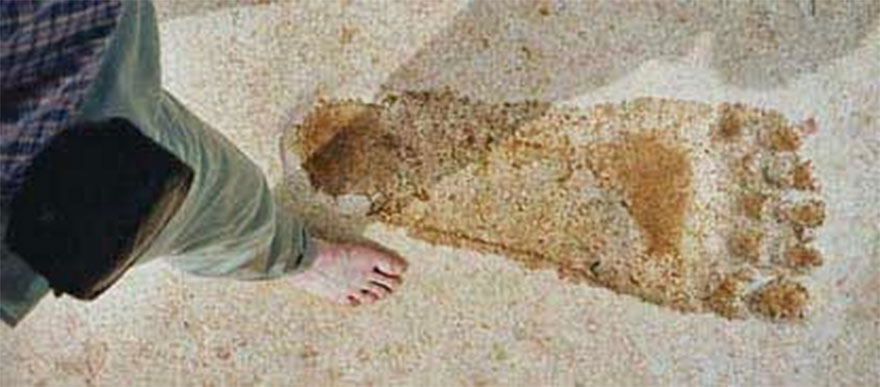
Footprint at Ain Dara Temple, Syria
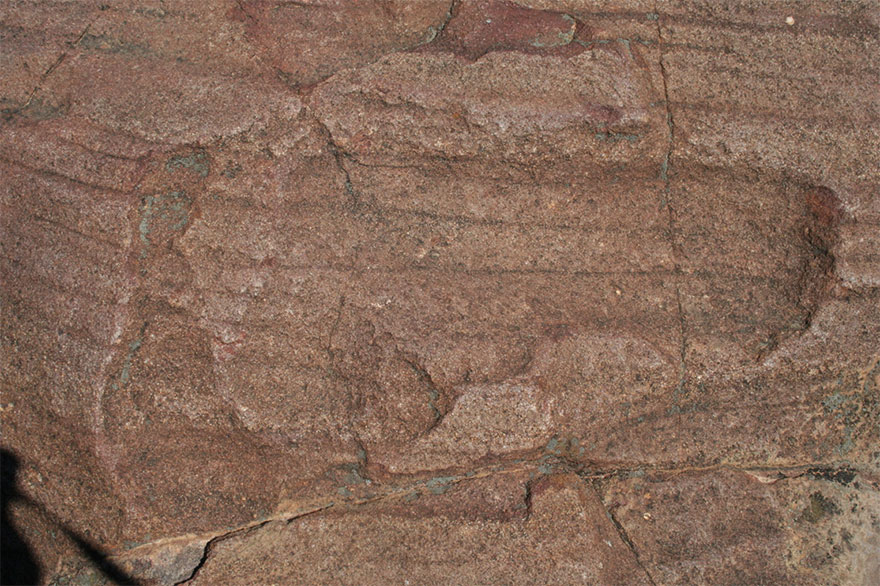
Giant Footprint Found in Botswana
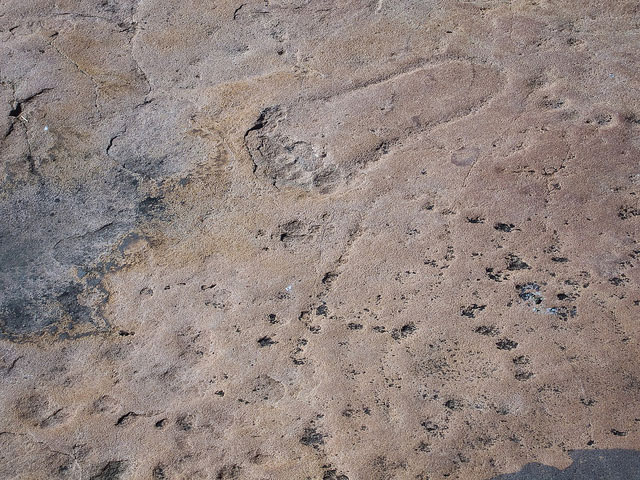
Giant Footprint Found in Botswana
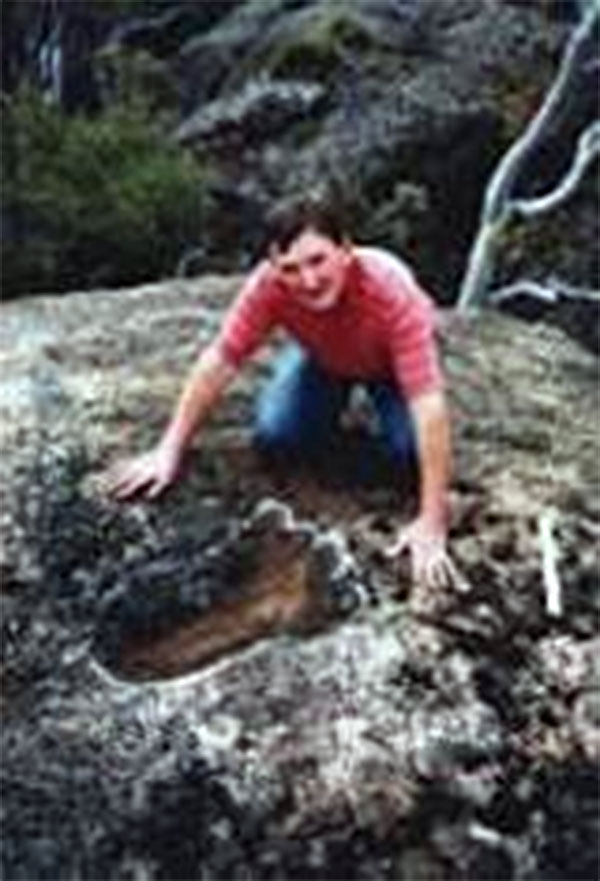
Giant Footprint Found in Australia
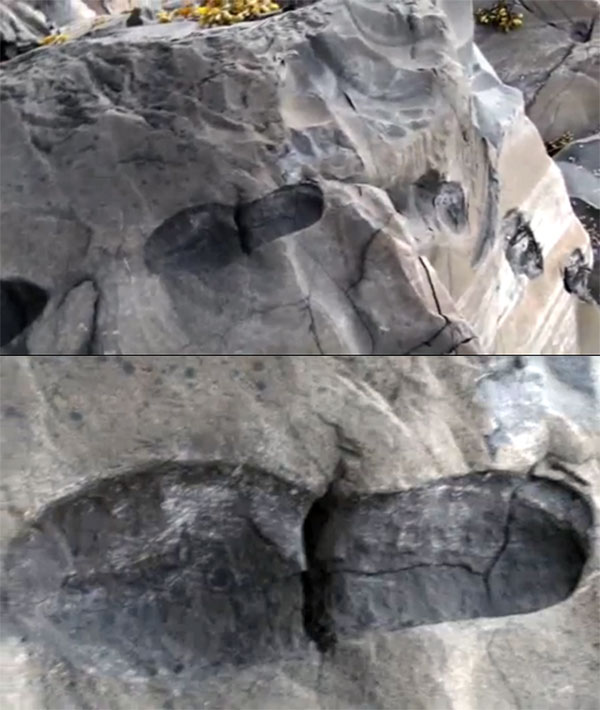
Ancient Footprint Trail Found in Alaska
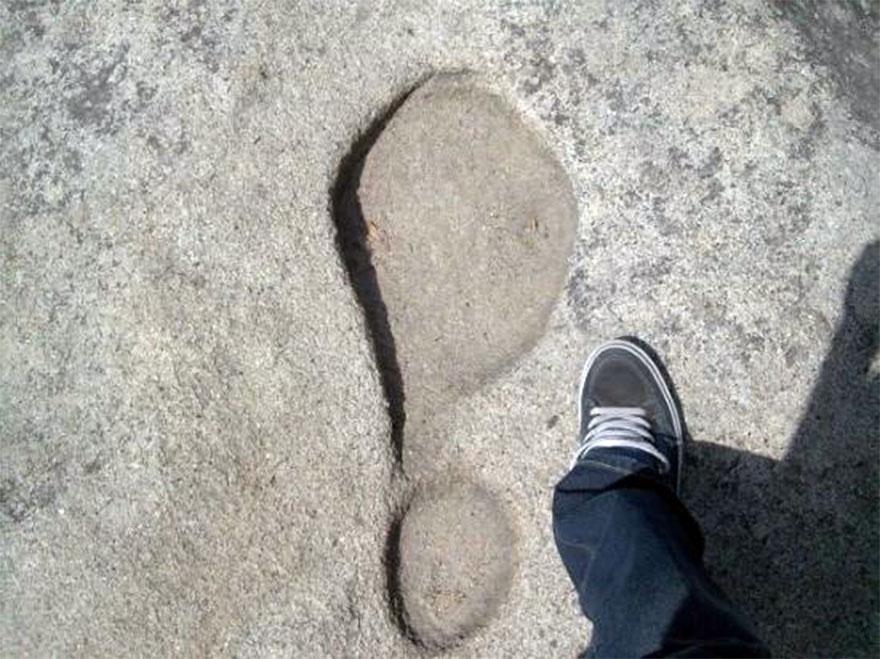
Giant Footprint Found at Lake Tahoe, USSA
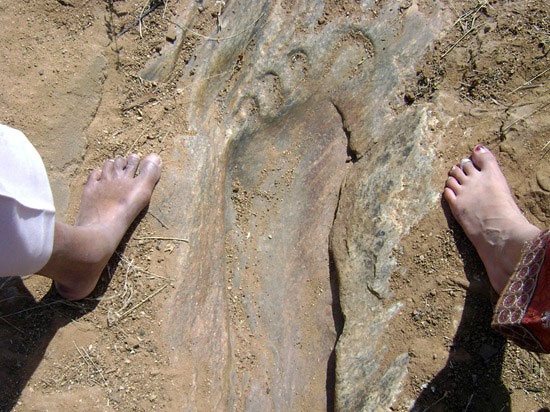
Giant Footprint of Bheema Found at Bheemana Hejje near Bangalore

Giant Footprint of Bheema Found at Bheemana Hejje near Bangalore
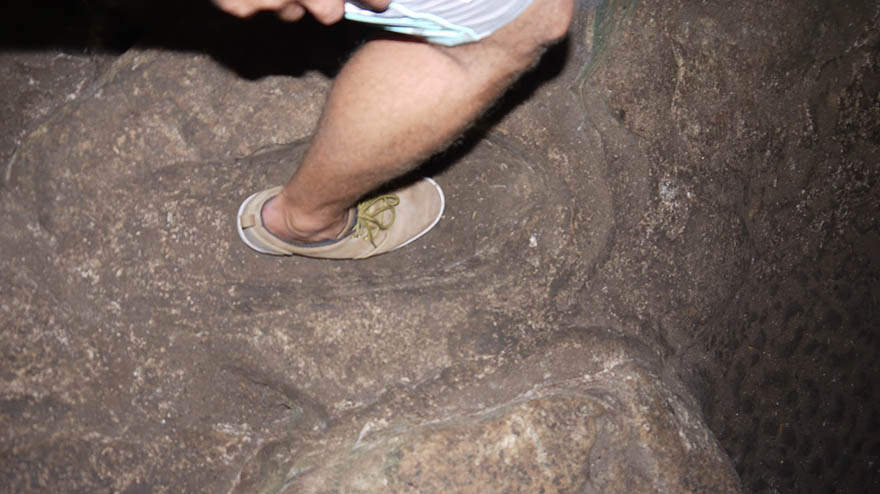
Giant Footprint Found in a Cave inBelize
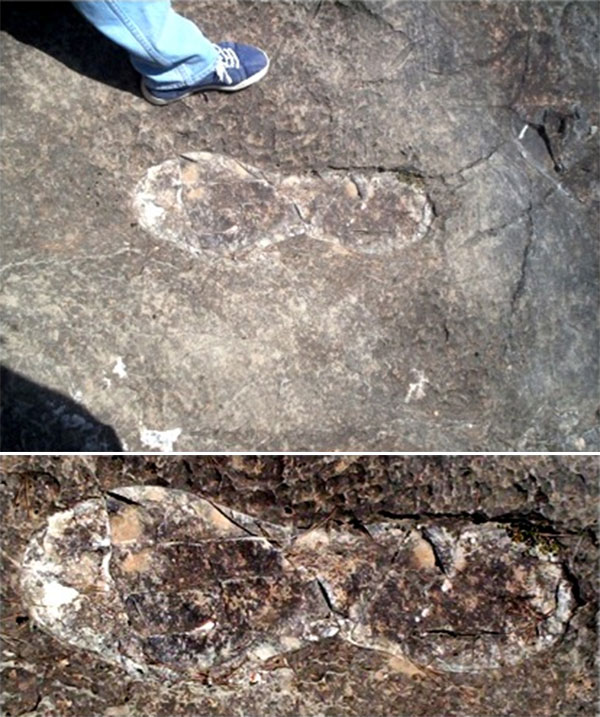
Giant Footprint Found in Valencia, Spain
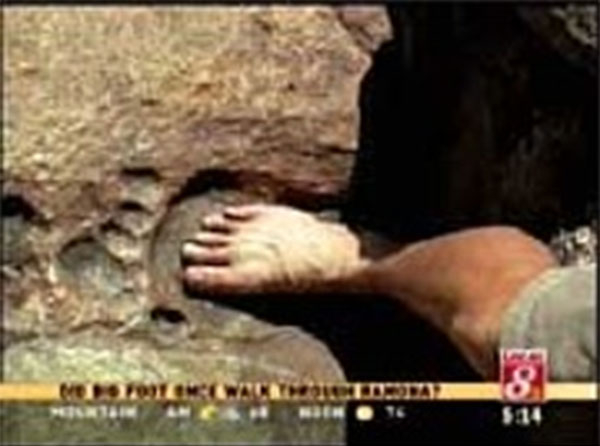
Giant Footprint Found at Cleveland, USA
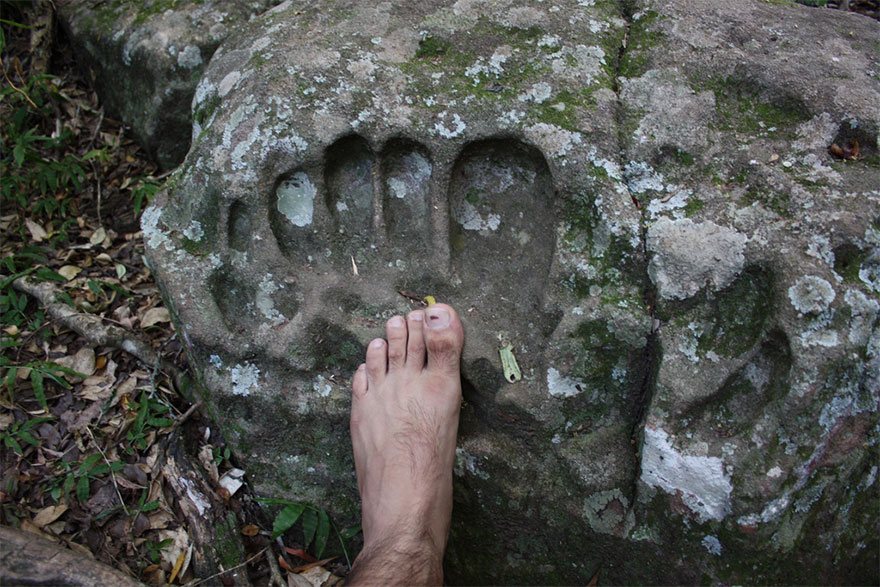
Giant Footprint Found in Paraguay
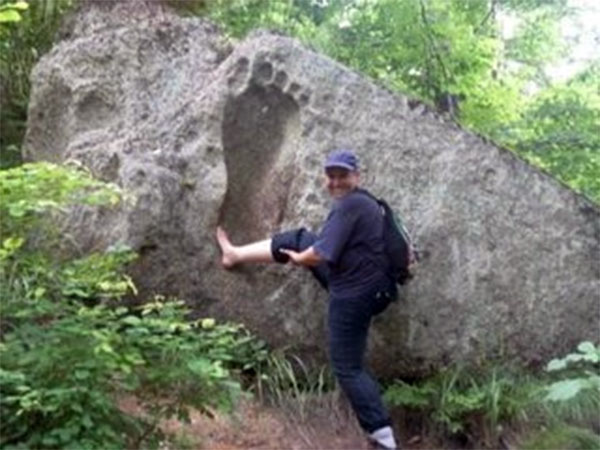
Giant Footprint Found in Lazovsky, Russia
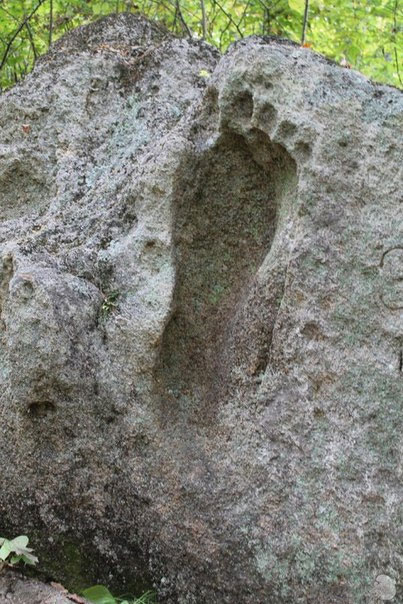
Giant Footprint Found in Lazovsky, Russia
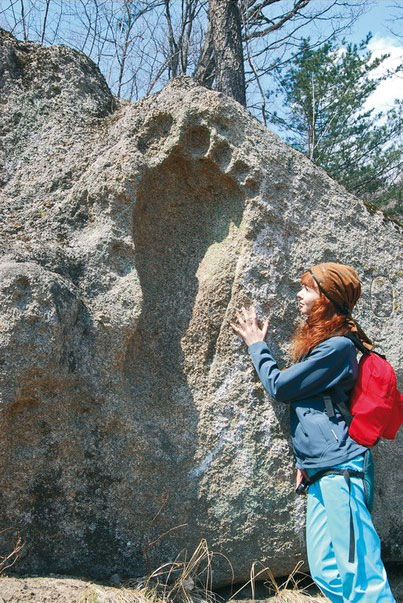
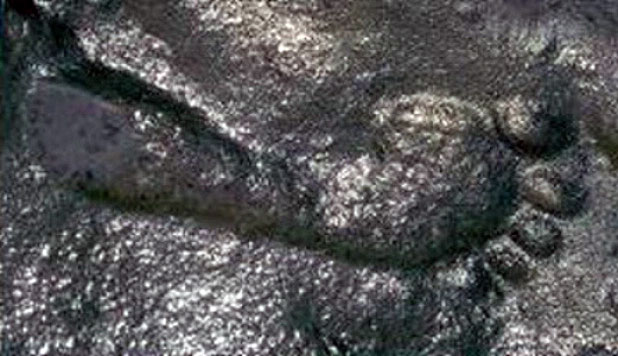
A perfectly formed 290 million year old human footprint found in New Mexico.
http://www.talkpundit.com/lord-hanumans-giant-footprints-throughout-asia/
Aug 13, 2015

Giant Footprint at Lepakshi, Andhra Pradesh
Most people are familiar with Lord Hanuman, the great devotee of Lord Rama mentioned in the Ramayana, but not everyone is aware that there are still physical traces of his ancient presence on earth in the form of his giant footprints left impressed into the solid stone where he lept and landed in different countries. Below we will show you four such places where Lord Hanuman’s footprint can be seen, as well as some examples of other giant footprints throughout the world, some of which are hundreds of millions of years old.

Lord Hanuman’s Footprint in Thailand
This above picture is of Lord Hanuman’s footprint in Thailand. In Thailand there is a book called “The Ramakien” which means “The Glory of Rama”. It is a Thai version of the ancient Sanskrit epic Ramayana. The ancient capital of Thailand used to be named “Ayutthaya”, which is named after Lord Ramachandra’s capital of Ayodhya in India. The present capital of Bangkok was originally a small trading post of Ayutthaya, located 40km away.

Giant Footprint at Lepakshi, Andhra Pradesh
The next three pictures show the footprint at Lepakshi in Andhra Pradesh. Some legends say the footprint is of Lord Hanuman, and others say it is the footprint of mother Sita.
The historic town of Lepakshi has a connection with an occurrence in the Indian epic of Ramayana. While Ravana was kidnapping Sita Devi and heading towards Lanka a bird named Jatayu had battled with him. He could not fight for long and fell at this place. According to the Valmiki Ramayana, Lord Rama accompanied by Lakshmana met the dying bird Jatayu at this spot. They helped him attain moksha by uttering the words “Le Pakshi,” which is Telugu for “Rise, bird”. Hence the name of the place has become Lepakshi.

Giant Footprint at Lepakshi, Andhra Pradesh

Giant Footprint at Lepakshi, Andhra Pradesh
The next picture is of Lord Hanuman’s footprint in Sri Lanka. It is believed that when Hanuman lept from India to Sri Lanka he landed at this spot and the force was so great that his footprint was left pressed into the solid stone.

Lord Hanuman’s Footprint in Sri Lanka
In Penang, Malaysia there is also a footprint of Lord Hanuman, which is kept within a small temple. In the next picture you can see the footprint. Visitors throw coins on the footprint for good luck.

Lord Hanuman’s Footprint in Malaysia
Besides these footprints of Lord Hanuman, there are many other giant footprints found throughout the world, which reveal the presence of super powerful beings on the earth in ancient times. In our Hindu scriptures we find countless references to powerful beings in the previous ages. Besides the presence of Devas (Demigods) visiting to the earth, there were many other higher species of humans such as the Yakshas, Rakshashas, Vanaras, and Gandharvas. Descriptions of these people found in the Puranas show they were often gigantic in size, flying in celestial airplanes that could travel from planet to planet, and wielding powerful weapons that were more effulgent than the sun.
In fact, J.R. Oppenheimer, the father of the atomic bomb, after the first successful test, quoted from the ancient Hindu scripture Bhagavad Gita to describe the weapon he had just invented. He also once hinted at the possibility of weapons on par with the nuclear ones he was working on having existed in previous eras, particularly those of the Ramayana and Mahabharata. Oppenheimer also claimed that, “access to the Vedas is the greatest privilege this century may claim over all previous centuries.” So while some people are quick to call our ancient scriptures as mythology, those who have scientifically studied the matter are more apt to consider them as actual ancient histories of the world.
“There were giants in the earth in those days; and also after that, when the sons of God came in unto the daughters of men, and they bare children to them, the same became the heroes and famous warriors of ancient times.” Genesis 6:4
Some of these footprints are hundreds of millions of years old, such as this next photo of a footprint that is over 200 million years old in South Africa. Of all the world scriptures, only the Vedas contain references to vast time spans, covering millions, billions and even trillions of years. Further, only the Vedic scriptures state that man has existed on this earth for hundreds of millions of years. The Vedic view is that there are many major and minor cycles of destruction (called pralayas) that occur over the life of the universe, which lasts trillions of years.
Just as there are seasons in the year, so there are also four cosmic seasons called as Yugas. The total time span of the four cosmic seasons is 4,320,000 years. Between each Yuga there is a partial dissolution in the world, where the world is destroyed through flood, fire and other natural disasters. The present age of Kali Yuga began 5,117 years ago, which also matches closely to both the Mayan calendar for the last destruction, and the Bible’s narration of the flood on the earth.
The Vedic scriptures describe that the present Kali Yuga is an age of evil, selfishness, destruction and all bad qualities. The word Kali means war in Sanskrit, so Kali Yuga means the age of war and destruction. The Vedas tell us that in this age the celestial beings who used to visit the earth avoid the earth due to the darkness of the age of Kali. That is one reason why today all we find are remnants of their presence in the form of their ancient footprints in stone.

Giant Footprint in South Africa

Giant Footprint Found in Texas, USA

100 Million Year Old Giant Footprint in Canada

Footprints at Ain Dara Temple, Syria

Footprints at Ain Dara Temple, Syria

Footprint at Ain Dara Temple, Syria

Giant Footprint Found in Botswana

Giant Footprint Found in Botswana

Giant Footprint Found in Australia

Ancient Footprint Trail Found in Alaska

Giant Footprint Found at Lake Tahoe, USSA

Giant Footprint of Bheema Found at Bheemana Hejje near Bangalore

Giant Footprint of Bheema Found at Bheemana Hejje near Bangalore

Giant Footprint Found in a Cave inBelize

Giant Footprint Found in Valencia, Spain

Giant Footprint Found at Cleveland, USA

Giant Footprint Found in Paraguay

Giant Footprint Found in Lazovsky, Russia

Giant Footprint Found in Lazovsky, Russia

Giant Footprint Found in Lazovsky, Russia

A perfectly formed 290 million year old human footprint found in New Mexico.
http://www.talkpundit.com/lord-hanumans-giant-footprints-throughout-asia/





